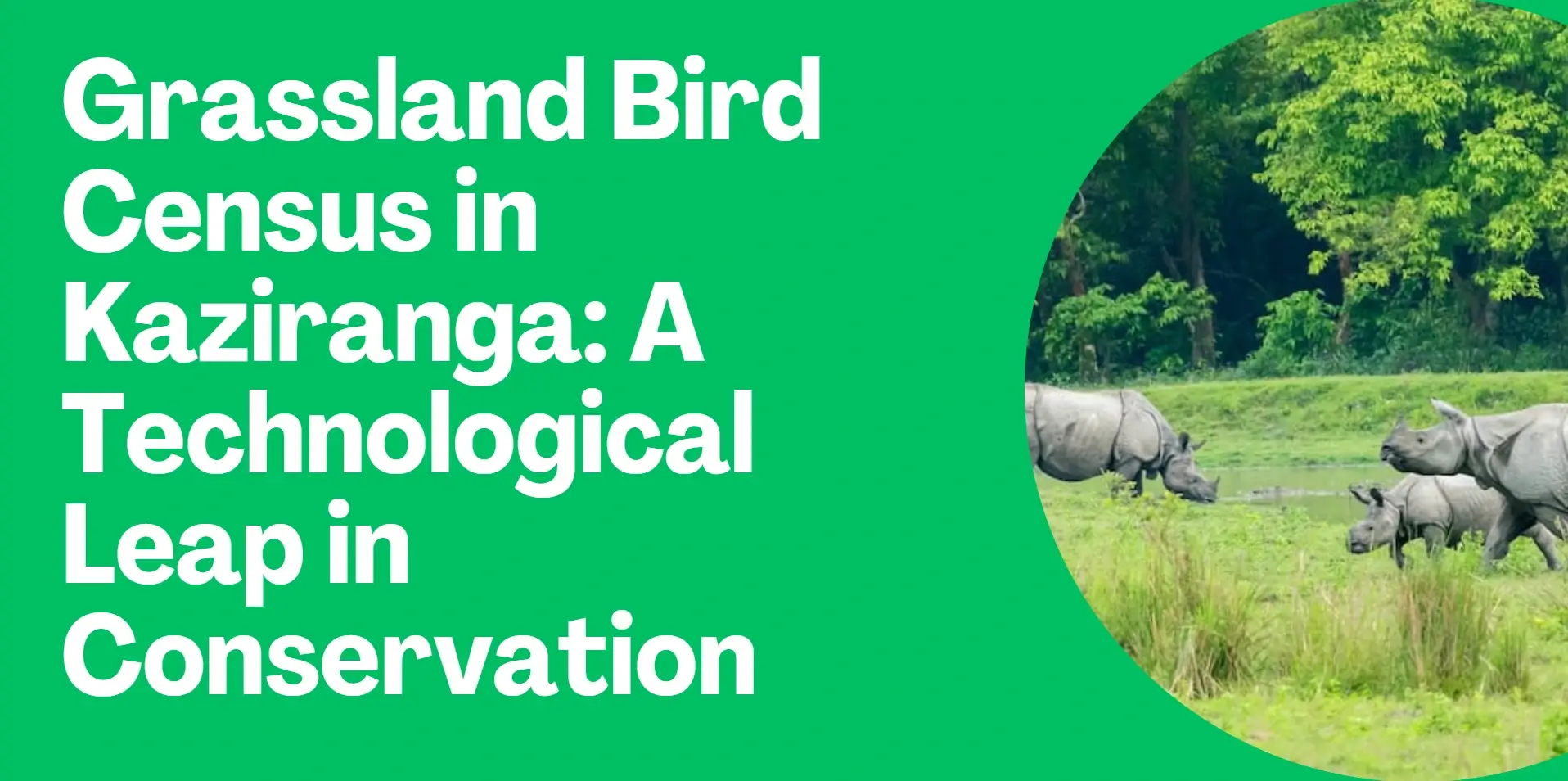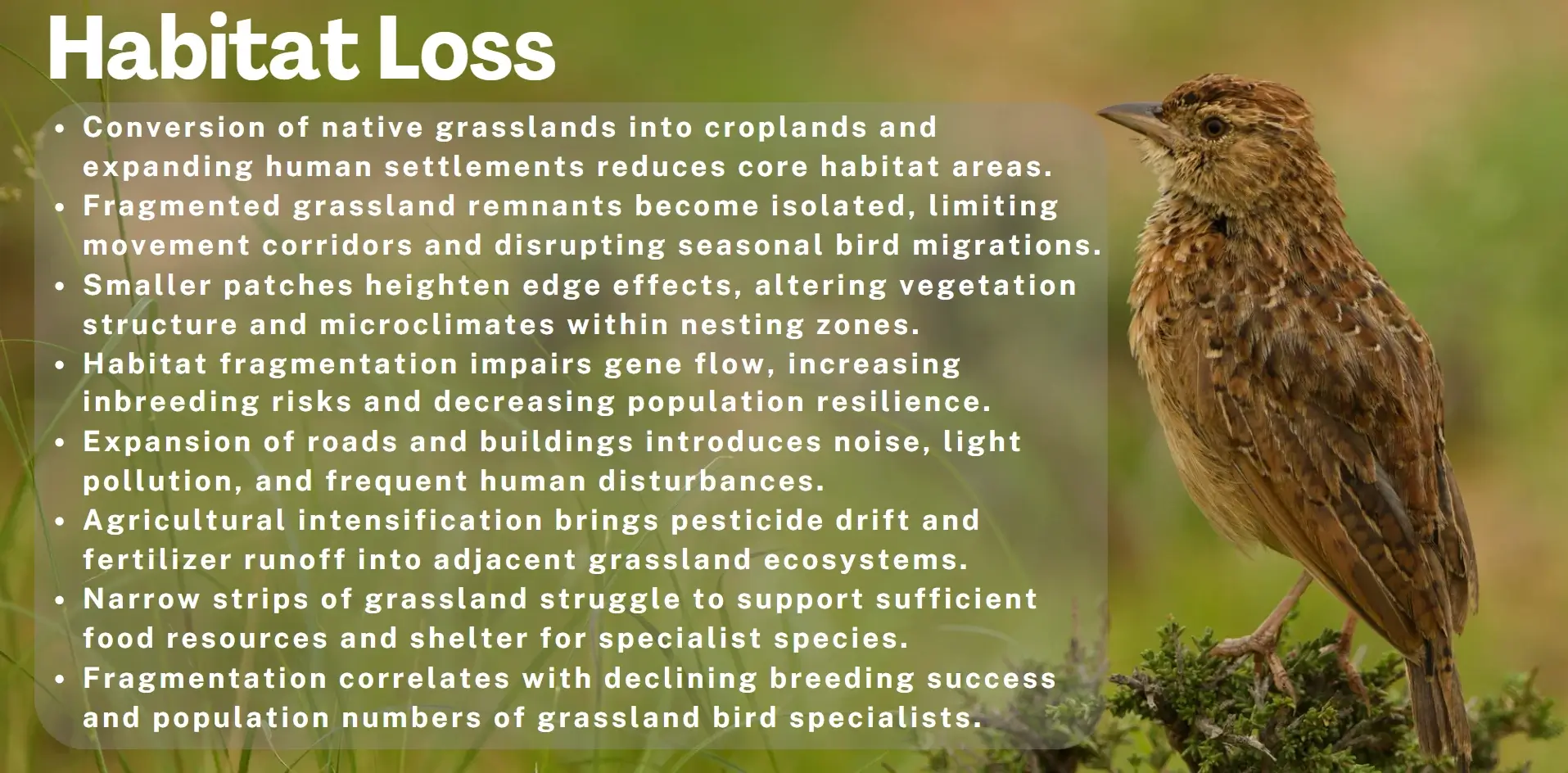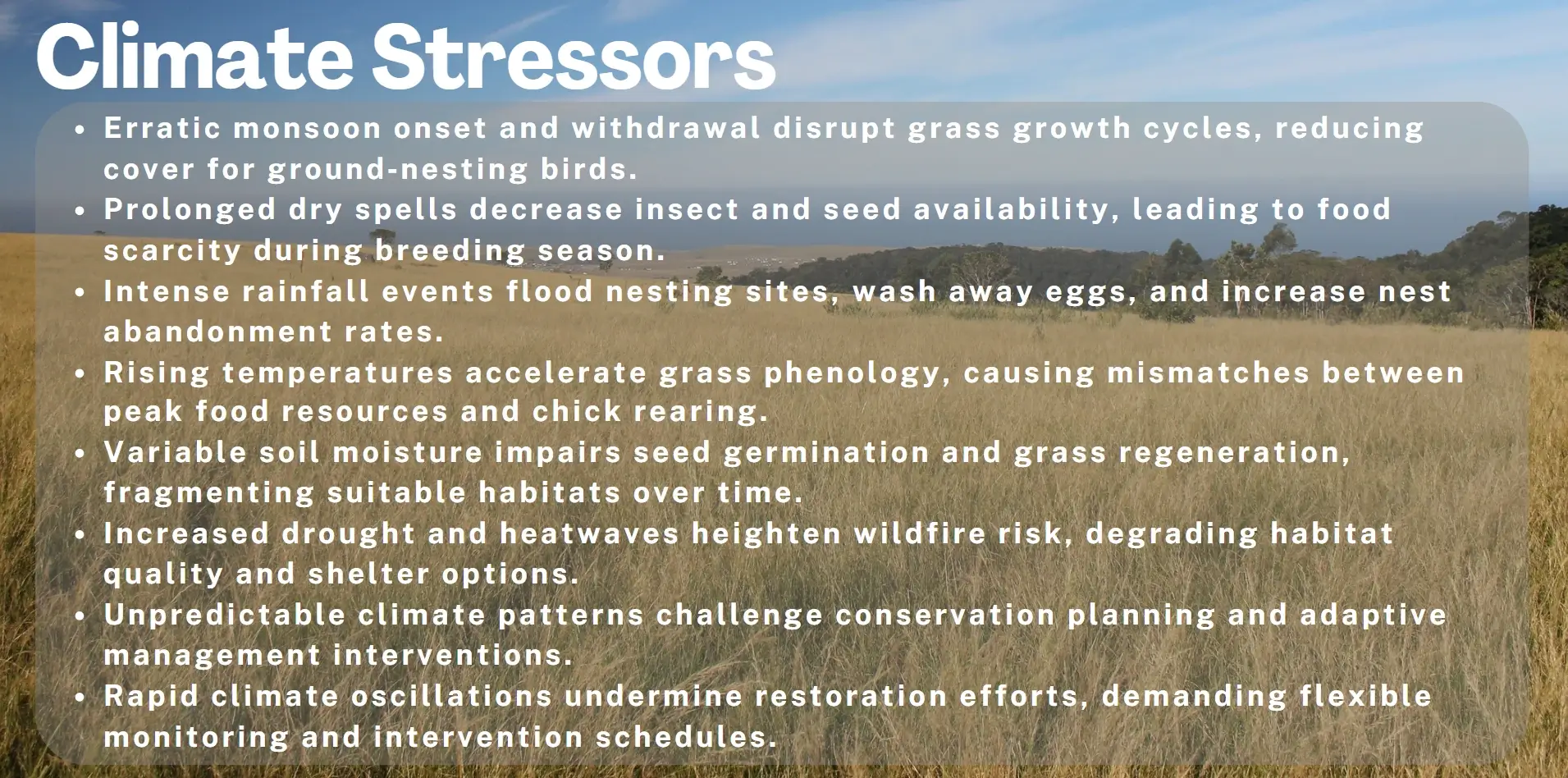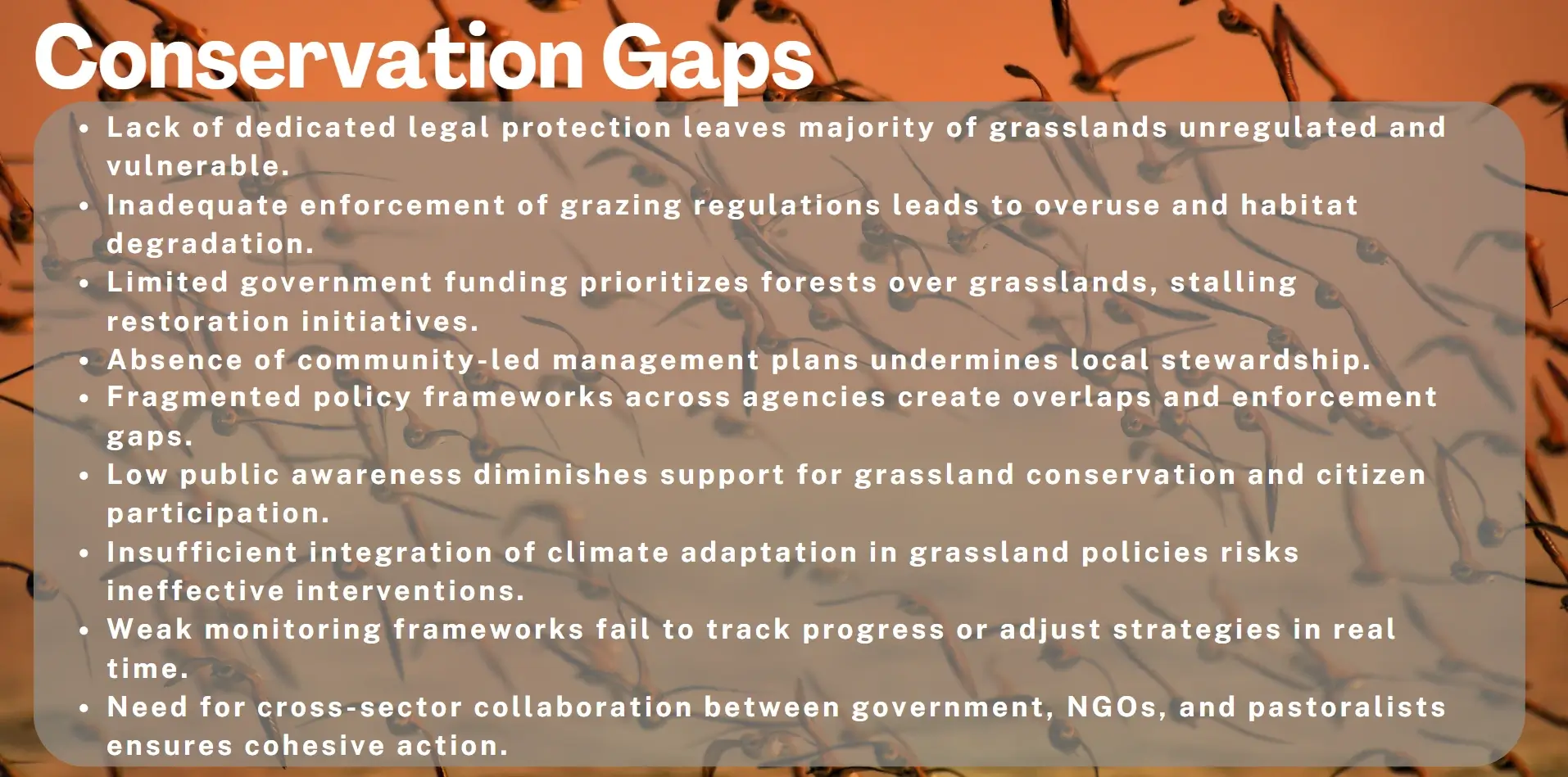The radical AI-based bird census in Kaziranga counted rare grassland birds and led to conservation consciousness following the national attention of Prime minister.

The Kaziranga National Park, the home to the one-horned rhinos and wetland fauna and flora, has just shifted the limelight onto a rather obscure, yet ecologically significant, group of animals i.e. grassland birds. It is the first time that the park has provided primary study on birds in grasslands and after Prime Minister Modi highlighted the census during his Mann kiBaat episode, the census received national attention. The fact that this survey incorporated artificial intelligence, passive acoustic monitoring, and point-count methods was what made it revolutionary as it redefined the study of elusive avian species in regularly dynamic and dense grassland habitats. Headed by a doctoral researcher Chiranjib Bora and assisted by the forest officials of Kaziranga, the survey discovered 43 bird species out of which 20 are endangered birds like the Bengal Florican and the Finns Weaver. The study provides a paradigm shift of conservation priority where it gives emphasis to the humid grassland habitats that many times do not get attention due to the emphasis put on the forest and wetland housing agendas. This background of this introduction explores the context behind the census, the scientific approach that was used and the relevance of the census to the country, all of which creates a lead into further discussion regarding the ecological effect and the policies that transpired as a result of the census. Faced with the problem of loss of biodiversity, such projects offer a light into the unexplored opportunities of applying technology to the ecological monitoring of the most threatened species in India that are disappearing out in silence.
Why this census is Special?
The initial census in Kaziranga of grassland birds (2025) was more than just the gathering of routine numbers; instead, it represented a dramatic change in India in the monitoring of neglected ecosystems and the avian life in it.
More than Mega fauna Icons
Kaziranga has been in the limelight of the world from past decades. This census is a record-breaker because it puts a spotlight on grassland birds which are seasonal, camouflaged and ecologically delicate. With such studies on these under-sampled species, scientists had shifted the conservation pendulum back by putting biodiversity in a different light other than what existed with the large mammals.
Ecological Sensitive Harnessing Technology
Passive acoustic monitoring proves to be a non-invasive technique that allows recording of the calls of the birds utilizing the devices installed on trees. This enabled non-intrusive spotting of shy and difficult to find species without altering their breeding trends. The AI applications such as BirdNET analyzed hours of the audio recording and classified species with record-licensing accuracy.
Local Impact Nationally Visible
The first-of-a-kind national attention came during Prime Minister Modi referring to the census during his talk show Mann kiBaat. It did not just represent appreciation of scientific ingenuity but also a form of ecological stewardship challenge. To the grassroots researchers and the forest employees, the endorsement justified their localized operations on a global scale.

Rare Breeding Colonies Discovery
A breeding colony of a Finns Weaver with over 85 active nests was one of the most intriguing finds; given the threat to the species, this was a significant ecological finding. And it has led to the discovery of the census methods being correct and to the necessity of periodic grassland bird surveys in the shifting habitats of India.
Methodology
The ecological ambition of the Kaziranga grassland bird census, in addition to being novel, is scientifically rigorous and non-invasive monitoring of elusive species of tall complex habitats.
Ecological Time of Survey
This census was planned during the breeding season of most grassland birds and this was carried out between March 18 and May 25, 2025. The importance of timingenabled the researchers to observe the vocal activity, nesting habits and movement patterns of the species at their most noticeable moments. This seasonal accuracy aided in maximizing the ecology knowledge and reduced the amount of stress to the wildlife.
Passive Acoustic Monitoring
In addressing this problem of cumbersomevegetation cover and an innate secretiveness to species in the grassland, researchers have employed passive acoustic monitoring. The sound recorders were attached to large trees and allowed to record the ambient sounds of birds. Such audio recordings were then converted into sound data, which would then be processed by artificial-intelligence-based software such as the BirdNET that would compare the signature voices with those of existing species.
Ai and Spectrograms
They used advanced software to produce spectrograms which are visual images of bird calls enabling differentiation of species to be done finely. Background noise, identifying certain patterns and even discriminating between overlapping calls of the different species would be possible to be filtered out by AI algorithms. These techniques helped to improve taxonomic precision, particularly on shy species such as the Marsh Babbler or Black breasted Parrotbill that cannot be easily observed.
Multidisciplinary work and On-Ground Validation
In support of remote sensing, the field staff conducted point-count surveys by being trained staff. Scientists joined efforts and shared knowledge in different fields including ornithology, forest ecology, and machine learning. Under the vision of the doctoral scholar Chiranjib Bora, the project brought together local knowledge with the scientific accuracy that data would be ecologically valid and socially anchored.
Special Findings and Species Mining
The bird census in Kaziranga grassland brought to light the findings beyond figures, providing a fresh meaning of biodiversity in the tall grassland habitat of India and bringing forth the imperative need of conservation of birds.
A Vast Landscape
An incredible 43 species of birds that are dependent on the grasslands were spotted in the survey with many not documented before to the precision in Kaziranga. This highlights the ecological value of the floodplain grasslands in the park, which occupies more than 70 percent of the park land but which is little studied relative to the wetlands and forests.
Rare and Threatened Species
Some of the most important discoveries included those of the critically endangered and vulnerable species, which are usually elusive and, therefore, do not appear in mainstream surveys. Bengal Florican, a spectacularly polygamous species in Bangladeshi auxiliary range, often found at low levels was positively identified by both acoustic and sighting. Two Endangered species were also noted in the survey, which are Finns Weaver as well as Swamp Grass Babbler both of which survive on uninterrupted grassland patches not only during nesting but also during foraging. Moreover six vulnerable species were seen some of which are the Black-breasted Parrotbill, Marsh Babbler, and Jerdon Babbler, which each have their role in ecological equilibrium.

The Landmark Discovery
One of the most significant findings perhaps was the recording of colony of a Finn Weaver with more than 85 nests that were operative. Those findings are ecologically important considering that this species is endangered as it has a fragmented distribution and specific requirements in nesting. The inhabitation of the colony does not merely indicate successful reproduction but also indicates good grassland poaches of habitation in Kaziranga which is vital in overall survival of the species in the long run.
Ecological and Conservation Value
The Kaziranga bird count is not just about listing species it is a re-definition of the way ecosystem health and habitat vulnerability should be conceptualized and set priorities in the rapidly transfiguring issues of biodiversity in India.
Grassland Birds
Frequentlythey are neglected, but they are sensitive measures of ecosystem health. The birds are specialty species and as such, they depend narrowly on a habitat, and therefore the trends of their population will be useful in such an assessment. Evidence of such species as the Bengal Florican or Swamp Grass Babbler indicates not just the structure of the grassland intact but also intact functioning of the food webs and the hydrological rhythms.
Tall Grasslands of Kaziranga
With almost 70 percent of Kaziranga terrestrial surface, tall grass ecosystems have been poorly represented in the national conservation efforts. This census follows their fundamental ecological purpose, namely to maintain breeding colonies, seed barrier, insect regulators. The survey also explains species richness in 185 locations and in the process highlights the biological abundance in these grasses, warranting them to be considered as important diversity stores.
Balance between Natural Succession and Needs of Management
Unchecked, grasslands can change slowly to woodlands or undergo a form of ecological succession. The increased growth of forests can be viewed as a good thing, but it puts some doubt on the habitat suitable to the grassland specialists. The census data also arms the park managers with the ability to strike the right balance between re-wilding instincts and species need in order to selectively burn, control grazing, and strategic clearings needed to maintain grassland structure.

Dangers facing Grassland Birds and their Habitats
The spontaneous census of bird population in grass land of Kaziranga indicated wealth of flora and fauna as well as the existing threats. Although they are ecologically important, the habitats are subject to increasing threats that could pose threats to the survival of species and long-term environmental stability.
Encroachment
Continued expansion of human settlement in park boundaries and runaway agricultural activities interfere with the natural grasslands dynamics of the area. Land conversion due to fodder farming, agriculture, and roads decreases the connectedness of the habitats and results in the loss of nesting sites directly. In the case of species that depend on large continuous grassland such as the Swamp Grass Babbler, this kind of fragmentation causes breeding failure and genetic impoverishment.
Overgrazing and Resource Competition
The grazing of cattle is common in the peripheral grasslands of Kaziranga and grazing cattle compete with each other and change plant structure. Excessive grazing causes a decline in the growth of vegetation, hence birds’ nests become vulnerable to predators and ground-nesting birds are disrupted. The decline in the cover also affects insects and invertebrates which are the major food source of grass land birds causing a cascading set of ecological effects.
Loss of Open Canopy
When not under the management, grasslands will shift into woodland or shrubland. On the one hand, such a development may be a blessing to some generalist species, but on the other hand, this is a death sentence to grassland species. Unless timely measures are taken in the form of controlled burning or mechanical clearing, then other species like Bengal Florican will lose breeding territories to denser vegetation and hence population will contract.
Implication of Policy and Management
Policy support, landscape management and levelled control are very important to the restoration of the integrity of the grassland and the future sustainability of reliant avian species. There has to be a holistic solution between ecological priorities and community resilience.
Whole of Landscape Governance
The application of conservation should not be limited at the national parks and sanctuaries, but also on community-managed grazing lands and seasonal floodplains. The semi-natural grasslands should be considered vital ecological cushion areas and a habitat to birds. To maintain open grasslands in the agro-ecological areas, zonal mapping, collaborating with stakeholders and incentive-based stewardship can assist in maintaining open grasslands.
Adaptive Monitoring and Adaptive Management
Management by local communities,forest departments along with citizen scientists Decentralized management could increase the strength of data collection, increase accountability and make repairs restorations, build on timelierhabitat preservation. Nesting success and vegetation dynamics monitoring allow managers to adapt methods of management such as rotational burning or controlled grazing, which yield more positive results in species.
Legal and Institutional Support
The legislations on conservation do not present the proper representation of the grassland birds. They may also be included in India Wildlife Protection schedules or own habitat conservation mechanisms that would open funding and planning assistance. Training, research grants, and inter-agency coordination will be an important component of institutional capacity that will enable policy to translate into action.
Conclusion
Grassland birds of India are ecological barometers as they are closely linked to the health of the habitat, migratory patterns and trophic interactions. However, their precarious survival is an indicator of degradation of the broader ecosystem in the face of several threats that include land-use alterations and livestock contact in addition to climatic vagaries. Kaziranga census reflects not only species diversity but also urgency: grasslands cannot be waste or sacrificial buffers to forests, they constitute important life biosphere that needs protection.There must be a shift in conservation between episodic interventions to lasting stewardship, which includes local participation, scientific management, and policy creativity. Restoring native grass species, controlling grazing, and keeping track of bird populations are all important actions, but they are not the only remedy when it comes to the reduction in grasslands. Just as India shapes a new conservation agenda, the future of beasts as the Bengal Florican and Swamp Grass Babbler can easily become a final confirmation of whether these lands are preserved as they are or traded to untenable change.